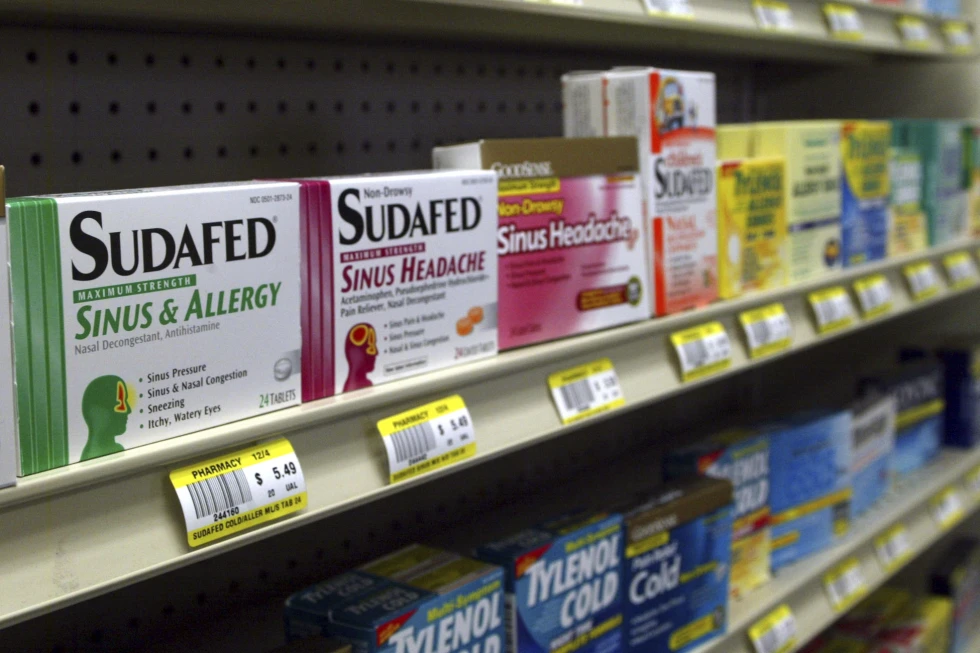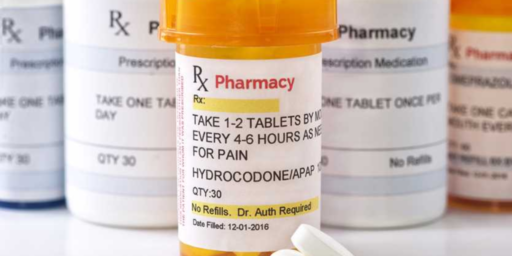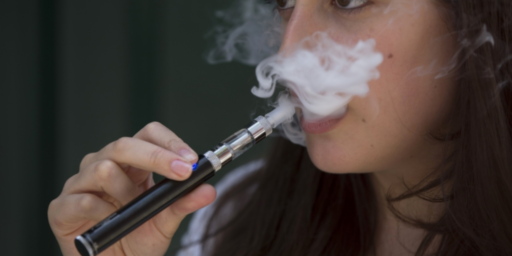Widely-Sold Decongestant Doesn’t Work
A tale of slow-moving bureaucracy.

AP (“Popular nasal decongestant doesn’t actually relieve congestion, FDA advisers say“):
The leading decongestant used by millions of Americans looking for relief from a stuffy nose is no better than a dummy pill, according to government experts who reviewed the latest research on the long-questioned drug ingredient.
Advisers to the Food and Drug Administration voted unanimously on Tuesday against the effectiveness of the key drug found in popular versions of Sudafed, Dayquil and other medications stocked on store shelves.
“Modern studies, when well conducted, are not showing any improvement in congestion with phenylephrine,” said Dr. Mark Dykewicz, an allergy specialist at the Saint Louis University School of Medicine.
This conjures two obvious questions. How did the drug get FDA approval to begin with? And it sure seems like Sudafed used to work, no?
The FDA assembled its outside advisers to take another look at phenylephrine, which became the main drug in over-the-counter decongestants when medicines with an older ingredient — pseudoephedrine — were moved behind pharmacy counters. A 2006 law had forced the move because pseudoephedrine can be illegally processed into methamphetamine.
Those original versions of Sudafed and other medicines remain available without a prescription, but they’re less popular and account for about one-fifth of the $2.2 billion market for oral decongestants. Phenylephrine versions — sometimes labeled “PE” on packaging — make up the rest.
Ah, yes, that’s right. They made it a pain in the ass to get the stuff we used for decades because some infinitesimal portion of the customer base was cooking meth with it. So, rather than jumping through hoops to get the good stuff, people shifted to an inferior product.
But, again, why was phenylephrine given FDA approval if it’s ineffective?
If the FDA follows through on the panel’s recommendations, Johnson & Johnson, Bayer and other drugmakers could be required to pull their oral medications containing phenylephrine from store shelves. That would likely force consumers to switch to the behind-the-counter pseudoephedrine products or to phenylephrine-based nasal sprays and drops.
In that scenario, the FDA would have to work with drugstores, pharmacists and other health providers to educate consumers about the remaining options for treating congestion, panelists said Tuesday.
The group also told the FDA that studying phenylephrine at higher doses was not an option because it can push blood pressure to potentially dangerous levels.
“I think there’s a safety issue there,” said Dr. Paul Pisaric of Archwell Health in Oklahoma. “I think this is a done deal as far as I’m concerned. It doesn’t work.”
This week’s two-day meeting was prompted by University of Florida researchers who petitioned the FDA to remove most phenylephrine products based on recent studies showing they failed to outperform placebo pills in patients with cold and allergy congestion. The same researchers also challenged the drug’s effectiveness in 2007, but the FDA allowed the products to remain on the market pending additional research.
So . . . the replacement came fifteen years ago, on the heels of the effective drug becoming hard to get, and it was pretty obvious from the get-go that it wasn’t very good. Yet the FDA said, Fuck it, we’ll let them sell it anyway until we know for sure that it doesn’t work? And now, fifteen years later, they’re getting around to thinking about pulling the approval?
“I feel this drug in this oral dose should have been removed from the market a long time ago,” said Jennifer Schwartzott, the patient representative on the panel. “Patients require and deserve medications that treat their symptoms safely and effectively and I don’t believe that this medication does that.”
The advisers essentially backed the conclusions of an FDA scientific review published ahead of this week’s meeting, which found numerous flaws in the 1960s and 1970s studies that supported phenylephrine’s original approval. The studies were “extremely small” and used statistical and research techniques no longer accepted by the agency, regulators said.
“The bottom line is that none of the original studies stand up to modern standards of study design or conduct,” said Dr. Peter Starke, the agency’s lead medical reviewer.
Additionally, three larger, rigorously conducted studies published since 2016 showed no difference between phenylephrine medications and placebos for relieving congestion. Those studies were conducted by Merck and Johnson & Johnson and enrolled hundreds of patients.
The FDA often gets criticized, occasionally including by me, for dragging its feet in approving drugs and procedures that are in wide use elsewhere in the developed world. So, why did they lean in the opposite direction with this one?
Like many other over-the-counter ingredients, phenylephrine was essentially grandfathered into approval during a sweeping FDA review begun in 1972. It has been sold in various forms for more than 75 years, predating the agency’s own regulations on drug effectiveness.
“Any time a product has been on the market that long, it’s human nature to make assumptions about what we think we know about the product,” said Dr. Theresa Michele, who leads the FDA’s office of nonprescription drugs.
Which . . . actually makes sense. The FDA’s resources are limited and they’re not going to spend a lot of effort on drugs that have been around a long time absent evidence that they’re actively harmful. I can’t fault them for that instant.
There’s also this:
But FDA reviewers said their latest assessment reflects new testing insights into how quickly phenylephrine is metabolized when taken by mouth, leaving only trace levels that reach nasal passages to relieve congestion. The drug appears more effective when applied directly to the nose, in sprays or drops, and those products are not under review.
So the drug actually is an effective decongestant. It’s just not effective in the oral form that’s most widely sold.
There’s unlikely to be any immediate impact from Tuesday’s panel vote, which is not binding.
The group’s negative opinion opens the door for the FDA to pull phenylephrine from a federal list of decongestants deemed effective for over-the-counter pills and liquids. The FDA said removing the products would eliminate “unnecessary costs and delay in care of taking a drug that has no benefit.”
The FDA’s nasal decongestants drug list, or monograph, has not been updated since 1995. The process for changing a monograph has traditionally taken years or decades, requiring multiple rounds of review and public comment. But a 2020 law passed by Congress streamlines the process, which should allow the FDA to accelerate the publication of new standards for nonprescription ingredients.
Well alrightee then.






Don’t forget that many pharmacies were already locking it up because shoplifters were clearing them out on a regular basis, presumably to be used for meth labs.
Back when Pseudoephedrine became harder to get, I noticed two things…the new stuff didn’t work, and a bunch of new products showed up under established names plastered with claims that they relieved congestion. I have always chosen medications based on their ingredients and steered clear of “multisymptom” products, preferring a chat with the pharmacist, who could give me better advice than the claims on the box. When I lived in Oregon, where the meth lab problem was pretty serious, Pseudoephedrine was not available even behind the counter without a prescription, so we got it in Washington when we visited relatives there. Oregon has since dropped that ban.
It’s not directly relevant to this specific case, but there is a much larger overall problem with epidemiological studies. See for example this paper exposing the methodological issues in the way these studies are typically conducted.
When I get a cold, I’ve trouble sleeping due to congestion. So, I do buy decongestants and take them an hour before bedtime.
But since March 2020 and masking, I just don’t care any more.
As someone who had horrible congestion due to allergies, I could tell right away this stuff didn’t work.
And the meth problem was horrible. People were stealing masses of the old medication, and independent pharmacies were badly affected. The other problem was the meth lab cleanups, which required a ridiculous amount of resources, including hazmat suits and disposal, not to mention the dangers of explosion.
The problem was substantial, and they threw whatever they could at it.
This is the same kind of #@&!ing bureaucratic mindset that had my physician only prescribe simple Tylenol pills following a kidney stone removal procedure. I was passing stone shards for three days! Think of cut diamonds, broken glass, and sand spurs passing through your urinary tract!! To hell with anyone who stands in the way of providing some relief from this kind of excruciating pain. FYI, I don’t generally like pain medication, as it makes me feel itchy, and do not in any way fit into the profile of a opioid drug user. All this to say, find a way to get people, who are not the problem, their needed medications, whether it’s decongestant, pain meds, etc., without creating untenable barriers or so much of a damn hassle.
We very occasionally need to intubate someone through the nose when we put someone on a ventilator. Some of us use phenylephrine as a decongestant to shrink the nasal passages and make a nose bleed less likely. So we knew it worked as a decongestant it just wasn’t widely known that it worked so poorly in the oral form, as is pointed out in the piece above. I dont think it was a high priority so it took a long time for this to be recognized.
The list of drugs that be used as precursors for making meth is pretty long. Not that long ago I learned that some of the asthma inhalers are used making it the 5th or 6th most common source. They are also pretty commonly abused in schools at about the middle school age. Anyway, meth is a problem and Sudafed was being stolen like crazy. Needs to just be another drug that is behind the counter and need limits on how much you can buy at one time.
Steve
I used to get sinus infections and congestion CONSTANTLY. A butcher of a dentist told me I had the second largest sinuses he’d since, the first largest being my mom’s. It was horrible after Pseudoephedrine went away. I would just gobble up anything that claimed to be a decongestant. Oddly enough, my nose job fixed all that. I haven’t had any sinus problems since. I freaking love my nose job.
@steve:
I like to read the after action reports that my docs and surgeons post on MyChart. I understand maybe half of it, but I really enjoy it for some reason. I was shocked to see that they treated the inside of my nose with liquid cocaine to stop the bleeding (or whatever). That was a wild rabbit hole to go down. Lol, all the cocaine, none of the fun.
This is no surprise. Back in the late 60’s and early 70’s when I was flying for uncle, the only decongestant the flight surgeon would give you without grounding was sudafed. We soon discovered the reason was that as a decongestant it was useless. We might as well as well have taken a sugar pill.
Beth- Some people think cocaine is a better vasoconstrictor than phenylephrine, especially older docs. I have used it for that purpose. Bad news for you is that it is dyed blue usually (at least what we use) so will be kind of obvious if you are using it. Gonna be hard to convince anyone other than the kids you are turning into a smurf.
Steve
@a country lawyer: Back then, Sudafed was pseudoephedrine not phenylephrine. Phenylephrine is what replaced pseudoephedrine in the OTC stuff.
The pseudoephedrine, for me at least, was the stuff that actually worked. Pregnant women were also OK to use Sudafed.
@Jen: Meaning, the original, pseudoephedrine is what worked for me, until I was prohibited from taking it due to high blood pressure…
The moron lobby is taking this well.
https://x.com/JackPosobiec/status/1701957622851572080?s=20
Lots of people convinced it is a plot to force people to get the COVID vaccine, etc. So, they’re going to go out and stockpile the useless medicine.
People were buying altered versions of Sudafed off the shelf cuz they couldn’t be bothered to goto the pharmacy counter for the real stuff? I didn’t even know they had altered stuff on the shelves. I just went to the pharmacy counter. Gah?
@Gustopher: That is hilarious, frankly you can see how short the leap is between this behavior and sending money to an alleged billionaire for his legal defense fund
@steve:
Lol, as open to experimentation as I am, I have a very strong no coke policy. That’s one of those things that I just know that I’ll like waaaaay to much. I have enough problems, I don’t need that one in the stack of 99. I also know myself well enough to know that I would be uncontrollably annoying to other people. I need things that shut me up, not bounce off the walls more.
@Beth: When mentoring new software engineers, I like to make sure they know that they can afford a cocaine addiction.
Why do I do this? I don’t know, but it just seems like one of the most important things for them to know. It comes up with them complaining about “my home office chair sucks” or similar.
To the best of my knowledge, none have moved forward with acquiring one (either a decent chair, or an addiction), but I try.
I am shocked that they finally got around to this. I thought everyone knew that the “PE” in “Sudafed PE” stands for Placebo Effect, and society had somehow decided that was fine.
@Kazzy: Over 70 years of sinus history. I’ve taken everything over the years. Sudafed was better than a poke in the eye with a sharp stick but that was all. The PE version wasn’t even that good but I stopped going to the pharmacy counter for it because they wouldn’t sell me a 30 day supply, for whatever reason they had.
@Gustopher: I’d never heard that one! Hehehe.
@just nutha: None of the tablets do anything for my constantly-crusty nose, not the useless OTC tabs or the ask-at-pharmacy-counter meth tabs.
Only the sprays (Afrin, Fluonase) provide relief. The real key is 1) rinsing my nasal opening a few times daily, and certainly after I’ve been outdoors and 2) using a nasal gel 2-3 times daily.
Did the OTC tabs actually work for anyone? Who was buying this junk and why? Placebo effect?
@DK: Claritin is okay for the runny nose part, but to reduce inflammation my experience is that a steroid/glucocorticoid nasal spray is necessary, and that they don’t all work equally well. For example, Afrin doesn’t do thing for me.
@Kazzy: First off, I doubt most people understood that the PE stuff wasn’t real Sudafed. Second, while it’s been quite some time since I bought the real stuff from behind the counter, it was a giant pain in the ass.
Normal OTC meds: Pick it out, put it in the cart with the rest of your stuff, and check out.
Sudafed: Wait in line 15-20 minutes behind people getting their meds or asking questions, produce ID, fill out various forms, be allowed to buy one box of the stuff, put it in the cart with the rest of your stuff, and check out.
The second is way less convenient.